Impact of Immunosuppressive Therapy on the Performance of Latent Tuberculosis Screening Tests in Patients with Inflammatory Bowel Disease: A Systematic Review and Meta-Analysis
Abstract
1. Introduction
2. Methods
2.1. Search Strategy
2.2. Inclusion/Exclusion Criteria
2.3. Study Selection
2.4. Quality Assessment
2.5. Data Extraction
2.6. Study Endpoints
2.7. Statistical Analysis
3. Results
3.1. Study Selection and Characteristics
3.2. IGRA-Positive or IGRA-Indeterminate Rates
3.3. TST-Positive Rates
3.4. Publication Bias
3.5. Sensitivity Analysis
3.6. Concordance Rates between IGRA and TST
4. Discussion
Supplementary Materials
Author Contributions
Funding
Institutional Review Board Statement
Informed Consent Statement
Data Availability Statement
Conflicts of Interest
Appendix A. Detailed Search Strategy
MEDLINE (Search Interface: PubMed)
- EMBASE (Search interface: Ovid)
- 1:
- (interferon gamma release assay or interferon gamma release assay or interferon gamma assay or IGRA or QuantiFERON or QuantiFERON-TB or QuantiFERONTB or T-SPOT or TSPOT-TB or tuberculin skin test or tuberculosis skin test or TST or PPD) and (inflammatory bowel or IBD or Crohn or Crohn’s or ulcerative colitis).ab,ti.
- 2:
- Limit 1 to (english language and embase and yr = “2000–Current”).
- Cochrane library
- #1:
- ‘interferon gamma release assay’ or ‘interferon-gamma release assay’ or ‘interferon gamma assay’ or IGRA or QuantiFERON or QuantiFERON-TB or QuantiFERONTB or T-SPOT or TSPOT-TB or ‘tuberculin skin test’ or ‘tuberculosis skin test’ or TST or PPD.
- #2:
- ‘inflammatory bowel’ or IBD or Crohn or Crohn’s or ‘ulcerative colitis’.
- #3:
- #1 and #2 (with Publication Year from 2000 to 2021, in Trials).
References
- Park, D.I.; Hisamatsu, T.; Chen, M.; Ng, S.C.; Ooi, C.J.; Wei, S.C.; Banerjee, R.; Hilmi, I.N.; Jeen, Y.T.; Han, D.S.; et al. Asian organization for crohn’s and colitis and asia pacific association of gastroenterology consensus on tuberculosis infection in patients with inflammatory bowel disease receiving anti-tumor necrosis factor treatment. Part 1: Risk assessment. Intest. Res. 2018, 16, 4–16. [Google Scholar] [CrossRef] [PubMed]
- Fallahi-Sichani, M.; El-Kebir, M.; Marino, S.; Kirschner, D.E.; Linderman, J.J. Multiscale computational modeling reveals a critical role for tnf-α receptor 1 dynamics in tuberculosis granuloma formation. J. Immunol. 2011, 186, 3472–3483. [Google Scholar] [CrossRef] [PubMed]
- Mohan, V.P.; Scanga, C.A.; Yu, K.; Scott, H.M.; Tanaka, K.E.; Tsang, E.; Tsai, M.M.; Flynn, J.L.; Chan, J. Effects of tumor necrosis factor alpha on host immune response in chronic persistent tuberculosis: Possible role for limiting pathology. Infect. Immun. 2001, 69, 1847–1855. [Google Scholar] [CrossRef] [PubMed]
- Hibi, T.; Kamae, I.; Pinton, P.; Ursos, L.; Iwakiri, R.; Hather, G.; Patel, H. Efficacy of biologic therapies for biologic-naïve japanese patients with moderately to severely active ulcerative colitis: A network meta-analysis. Intest. Res. 2021, 19, 53–61. [Google Scholar] [CrossRef]
- Oh, S.J.; Shin, G.Y.; Soh, H.; Lee, J.G.; Im, J.P.; Eun, C.S.; Lee, K.M.; Park, D.I.; Han, D.S.; Kim, H.J.; et al. Long-term outcomes of infliximab in a real-world multicenter cohort of patients with acute severe ulcerative colitis. Intest. Res. 2021, 19, 323–331. [Google Scholar] [CrossRef]
- Keane, J.; Gershon, S.; Wise, R.P.; Mirabile-Levens, E.; Kasznica, J.; Schwieterman, W.D.; Siegel, J.N.; Braun, M.M. Tuberculosis associated with infliximab, a tumor necrosis factor alpha-neutralizing agent. N. Engl. J. Med. 2001, 345, 1098–1104. [Google Scholar] [CrossRef] [PubMed]
- Ruan, Q.; Zhang, S.; Ai, J.; Shao, L.; Zhang, W. Screening of latent tuberculosis infection by interferon-γ release assays in rheumatic patients: A systemic review and meta-analysis. Clin. Rheumatol. 2016, 35, 417–425. [Google Scholar] [CrossRef]
- Pai, M.; Zwerling, A.; Menzies, D. Systematic review: T-cell-based assays for the diagnosis of latent tuberculosis infection: An update. Ann. Intern. Med. 2008, 149, 177–184. [Google Scholar] [CrossRef]
- Menzies, D.; Pai, M.; Comstock, G. Meta-analysis: New tests for the diagnosis of latent tuberculosis infection: Areas of uncertainty and recommendations for research. Ann. Intern. Med. 2007, 146, 340–354. [Google Scholar] [CrossRef]
- Matulis, G.; Jüni, P.; Villiger, P.M.; Gadola, S.D. Detection of latent tuberculosis in immunosuppressed patients with autoimmune diseases: Performance of a mycobacterium tuberculosis antigen-specific interferon gamma assay. Ann. Rheum. Dis. 2008, 67, 84–90. [Google Scholar] [CrossRef]
- Sester, U.; Wilkens, H.; van Bentum, K.; Singh, M.; Sybrecht, G.W.; Schäfers, H.J.; Sester, M. Impaired detection of Mycobacterium tuberculosis immunity in patients using high levels of immunosuppressive drugs. Eur. Respir. J. 2009, 34, 702–710. [Google Scholar] [CrossRef] [PubMed]
- Shahidi, N.; Fu, Y.T.; Qian, H.; Bressler, B. Performance of interferon-gamma release assays in patients with inflammatory bowel disease: A systematic review and meta-analysis. Inflamm. Bowel Dis. 2012, 18, 2034–2042. [Google Scholar] [CrossRef] [PubMed]
- Alrajhi, S.; Germain, P.; Martel, M.; Lakatos, P.; Bessissow, T.; Al-Taweel, T.; Afif, W. Concordance between tuberculin skin test and interferon-gamma release assay for latent tuberculosis screening in inflammatory bowel disease. Intest. Res. 2020, 18, 306–314. [Google Scholar] [CrossRef] [PubMed]
- Stang, A. Critical evaluation of the newcastle-ottawa scale for the assessment of the quality of nonrandomized studies in meta-analyses. Eur. J. Epidemiol. 2010, 25, 603–605. [Google Scholar] [CrossRef]
- Lewinsohn, D.M.; Leonard, M.K.; LoBue, P.A.; Cohn, D.L.; Daley, C.L.; Desmond, E.; Keane, J.; Lewinsohn, D.A.; Loeffler, A.M.; Mazurek, G.H.; et al. Official american thoracic society/infectious diseases society of america/centers for disease control and prevention clinical practice guidelines: Diagnosis of tuberculosis in adults and children. Clin. Infect. Dis. 2017, 64, 111–115. [Google Scholar] [CrossRef]
- Higgins, J.P.; Thompson, S.G.; Deeks, J.J.; Altman, D.G. Measuring inconsistency in meta-analyses. BMJ 2003, 327, 557–560. [Google Scholar] [CrossRef] [PubMed]
- Egger, M.; Davey Smith, G.; Schneider, M.; Minder, C. Bias in meta-analysis detected by a simple, graphical test. BMJ 1997, 315, 629–634. [Google Scholar] [CrossRef]
- Higgins, J.; Green, S. Cochrane Handbook for Systematic Reviews of Interventions, Version 5.1.0. Available online: https://handbook-5-1.cochrane.org/ (accessed on 21 November 2021).
- Liberati, A.; Altman, D.G.; Tetzlaff, J.; Mulrow, C.; Gøtzsche, P.C.; Ioannidis, J.P.; Clarke, M.; Devereaux, P.J.; Kleijnen, J.; Moher, D. The prisma statement for reporting systematic reviews and meta-analyses of studies that evaluate health care interventions: Explanation and elaboration. J. Clin. Epidemiol. 2009, 62, e1–e34. [Google Scholar] [CrossRef]
- Viechtbauer, W. Conducting meta-analyses in r with the metafor package. J. Stat. Softw. 2010, 36, 1–48. [Google Scholar] [CrossRef]
- Balduzzi, S.; Rücker, G.; Schwarzer, G. How to perform a meta-analysis with r: A practical tutorial. Evid. Based Ment. Health 2019, 22, 153–160. [Google Scholar] [CrossRef]
- Schoepfer, A.M.; Flogerzi, B.; Fallegger, S.; Schaffer, T.; Mueller, S.; Nicod, L.; Seibold, F. Comparison of interferon-gamma release assay versus tuberculin skin test for tuberculosis screening in inflammatory bowel disease. Am. J. Gastroenterol. 2008, 103, 2799–2806. [Google Scholar] [CrossRef] [PubMed]
- Papay, P.; Eser, A.; Winkler, S.; Frantal, S.; Primas, C.; Miehsler, W.; Novacek, G.; Vogelsang, H.; Dejaco, C.; Reinisch, W. Factors impacting the results of interferon-γ release assay and tuberculin skin test in routine screening for latent tuberculosis in patients with inflammatory bowel diseases. Inflamm. Bowel Dis. 2011, 17, 84–90. [Google Scholar] [CrossRef]
- Qumseya, B.J.; Ananthakrishnan, A.N.; Skaros, S.; Bonner, M.; Issa, M.; Zadvornova, Y.; Naik, A.; Perera, L.; Binion, D.G. Quantiferon tb gold testing for tuberculosis screening in an inflammatory bowel disease cohort in the united states. Inflamm. Bowel Dis. 2011, 17, 77–83. [Google Scholar] [CrossRef] [PubMed]
- Mariette, X.; Baron, G.; Tubach, F.; Lioté, F.; Combe, B.; Miceli-Richard, C.; Flipo, R.M.; Goupille, P.; Allez, M.; Salmon, D.; et al. Influence of replacing tuberculin skin test with ex vivo interferon γ release assays on decision to administer prophylactic antituberculosis antibiotics before anti-tnf therapy. Ann. Rheum. Dis. 2012, 71, 1783–1790. [Google Scholar] [CrossRef] [PubMed]
- Andrisani, G.; Armuzzi, A.; Papa, A.; Marzo, M.; Felice, C.; Pugliese, D.; De Vitis, I.; Rapaccini, G.L.; Guidi, L. Comparison of quantiferon-tb gold versus tuberculin skin test for tuberculosis screening in inflammatory bowel disease patients. J. Gastrointest. Liver Dis. 2013, 22, 21–25. [Google Scholar]
- Greveson, K.; Goodhand, J.; Capocci, S.; Woodward, S.; Murray, C.; Cropley, I.; Hamilton, M.; Lipman, M. Yield and cost effectiveness of mycobacterial infection detection using a simple igra-based protocol in uk subjects with inflammatory bowel disease suitable for anti-tnfα therapy. J. Crohns Colitis 2013, 7, 412–418. [Google Scholar] [CrossRef]
- Ramos, J.M.; Masiá, M.; Rodríguez, J.C.; López, C.; Padilla, S.; Robledano, C.; Navarro-Blasco, F.J.; Matarredona, J.; García-Sepulcre, M.F.; Gutiérrez, F. Negative effect of immunosuppressive therapy in the performance of the quantiferon gold in-tube test in patients with immune-mediated inflammatory diseases. Clin. Exp. Med. 2013, 13, 177–186. [Google Scholar] [CrossRef]
- Arias-Guillén, M.; Riestra, S.; de Francisco, R.; Palacios, J.J.; Belda, J.; Escalante, P.; Pérez-Martínez, I.; Molinos, L.M.; Garcia-Clemente, M.; Pando-Sandoval, A.; et al. T-cell profiling and the immunodiagnosis of latent tuberculosis infection in patients with inflammatory bowel disease. Inflamm. Bowel Dis. 2014, 20, 329–338. [Google Scholar] [CrossRef]
- Wong, S.H.; Ip, M.; Tang, W.; Lin, Z.; Kee, C.; Hung, E.; Lui, G.; Lee, N.; Chan, F.K.; Wu, J.C.; et al. Performance of interferon-gamma release assay for tuberculosis screening in inflammatory bowel disease patients. Inflamm. Bowel Dis. 2014, 20, 2067–2072. [Google Scholar] [CrossRef]
- Çekiç, C.; Aslan, F.; Vatansever, S.; Topal, F.; Yüksel, E.S.; Alper, E.; Dallı, A.; Ünsal, B. Latent tuberculosis screening tests and active tuberculosis infection rates in turkish inflammatory bowel disease patients under anti-tumor necrosis factor therapy. Ann. Gastroenterol. 2015, 28, 241–246. [Google Scholar]
- Mantzaris, G.J.; Tsironikos, D.; Tzanetakou, X.; Grispou, E.; Karatzas, P.; Kalogeropoulos, I.; Papamichael, K. The impact of immunosuppressive therapy on quantiferon and tuberculin skin test for screening of latent tuberculosis in patients with inflammatory bowel disease scheduled for anti-tnf therapy. Scand. J. Gastroenterol. 2015, 50, 1451–1455. [Google Scholar] [CrossRef] [PubMed]
- Abreu, C.; Almeida, F.; Ferraz, R.; Dias, C.C.; Sarmento, A.; Magro, F. The tuberculin skin test still matters for the screening of latent tuberculosis infections among inflammatory bowel disease patients. Dig. Liver Dis. 2016, 48, 1438–1443. [Google Scholar] [CrossRef] [PubMed]
- Song, D.J.; Tong, J.L.; Peng, J.C.; Cai, C.W.; Xu, X.T.; Zhu, M.M.; Ran, Z.H.; Zheng, Q. Tuberculosis screening using igra and chest computed tomography in patients with inflammatory bowel disease: A retrospective study. J. Dig. Dis. 2017, 18, 23–30. [Google Scholar] [CrossRef][Green Version]
- Taxonera, C.; Ponferrada, Á.; Bermejo, F.; Riestra, S.; Saro, C.; Martín-Arranz, M.D.; Cabriada, J.L.; Barreiro-de Acosta, M.; de Castro, M.L.; López-Serrano, P.; et al. Early tuberculin skin test for the diagnosis of latent tuberculosis infection in patients with inflammatory bowel disease. J. Crohns Colitis 2017, 11, 792–800. [Google Scholar] [CrossRef]
- Vajravelu, R.K.; Osterman, M.T.; Aberra, F.N.; Roy, J.A.; Lichtenstein, G.R.; Mamtani, R.; Goldberg, D.S.; Lewis, J.D.; Scott, F.I. Indeterminate quantiferon-tb gold increases likelihood of inflammatory bowel disease treatment delay and hospitalization. Inflamm. Bowel Dis. 2017, 24, 217–226. [Google Scholar] [CrossRef] [PubMed]
- Al-Taweel, T.; Strohl, M.; Pai, M.; Martel, M.; Bessissow, T.; Bitton, A.; Seidman, E.; Afif, W. A study of optimal screening for latent tuberculosis in patients with inflammatory bowel disease. Dig. Dis. Sci. 2018, 63, 2695–2702. [Google Scholar] [CrossRef] [PubMed]
- Cabriada, J.L.; Ruiz-Zorrilla, R.; Barrio, J.; Atienza, R.; Huerta, A.; Rodríguez-Lago, I.; Bernal, A.; Herrero, C. Screening for latent tuberculosis infection in patients with inflammatory bowel disease: Can interferon-gamma release assays replace the tuberculin skin test? Turk. J. Gastroenterol. 2018, 29, 292–298. [Google Scholar] [CrossRef]
- Thi, A.A.; Abbara, A.; Bouri, S.; Collin, S.M.; Wolfson, P.; Owen, L.; Buell, K.G.; John, L.; Hart, A.L. Challenges in screening for latent tuberculosis in inflammatory bowel disease prior to biologic treatment: A uk cohort study. Frontline Gastroenterol. 2018, 9, 234–240. [Google Scholar] [CrossRef]
- Amorim, R.F.; Viegas, E.R.C.; Carneiro, A.J.V.; Esberard, B.C.; Chinem, E.S.; Correa, R.S.; Rodrigues, L.; Ribeiro-Alves, M.; Silva, K.S.; de Souza, H.S.; et al. Superiority of interferon gamma assay over tuberculin skin test for latent tuberculosis in inflammatory bowel disease patients in brazil. Dig. Dis. Sci. 2019, 64, 1916–1922. [Google Scholar] [CrossRef]
- Mantri, A.K.; Meena, P.; Puri, A.S.; Kumar, A.; Sachdeva, S.; Srivastava, S.; Arivarasan, K.; Varakanahali, S. Comparison of interferon-gamma release assay and tuberculin skin test for the screening of latent tuberculosis in inflammatory bowel disease patients: Indian scenario. Tuberc. Res. Treat. 2021, 2021, 6682840. [Google Scholar] [CrossRef]
- Wong, S.H.; Gao, Q.; Tsoi, K.K.; Wu, W.K.; Tam, L.S.; Lee, N.; Chan, F.K.; Wu, J.C.; Sung, J.J.; Ng, S.C. Effect of immunosuppressive therapy on interferon γ release assay for latent tuberculosis screening in patients with autoimmune diseases: A systematic review and meta-analysis. Thorax 2016, 71, 64–72. [Google Scholar] [CrossRef] [PubMed]
- Auguste, P.; Tsertsvadze, A.; Pink, J.; Court, R.; McCarthy, N.; Sutcliffe, P.; Clarke, A. Comparing interferon-gamma release assays with tuberculin skin test for identifying latent tuberculosis infection that progresses to active tuberculosis: Systematic review and meta-analysis. BMC Infect. Dis. 2017, 17, 200. [Google Scholar] [CrossRef] [PubMed]
- Singh, A.; Mahajan, R.; Kedia, S.; Dutta, A.K.; Anand, A.; Bernstein, C.N.; Desai, D.; Pai, C.G.; Makharia, G.; Tevethia, H.V.; et al. Use of thiopurines in inflammatory bowel disease: An update. Intest. Res. 2021, 20, 11–30. [Google Scholar] [CrossRef] [PubMed]
- Aniwan, S.; Limsrivilai, J.; Pongprasobchai, S.; Pausawasdi, N.; Prueksapanich, P.; Kongtub, N.; Rerknimitr, R. Temporal trend in the natural history of ulcerative colitis in a country with a low incidence of ulcerative colitis from 2000 through 2018. Intest. Res. 2021, 19, 186–193. [Google Scholar] [CrossRef]
- Jung, Y.J.; Lee, J.Y.; Jo, K.W.; Yoo, B.; Lee, C.K.; Kim, Y.G.; Yang, S.K.; Byeon, J.S.; Kim, K.J.; Ye, B.D.; et al. The ‘either test positive’ strategy for latent tuberculous infection before anti-tumour necrosis factor treatment. Int. J. Tuberc. Lung. Dis. 2014, 18, 428–434. [Google Scholar] [CrossRef]
- Hasan, T.; Au, E.; Chen, S.; Tong, A.; Wong, G. Screening and prevention for latent tuberculosis in immunosuppressed patients at risk for tuberculosis: A systematic review of clinical practice guidelines. BMJ Open 2018, 8, e022445. [Google Scholar] [CrossRef]
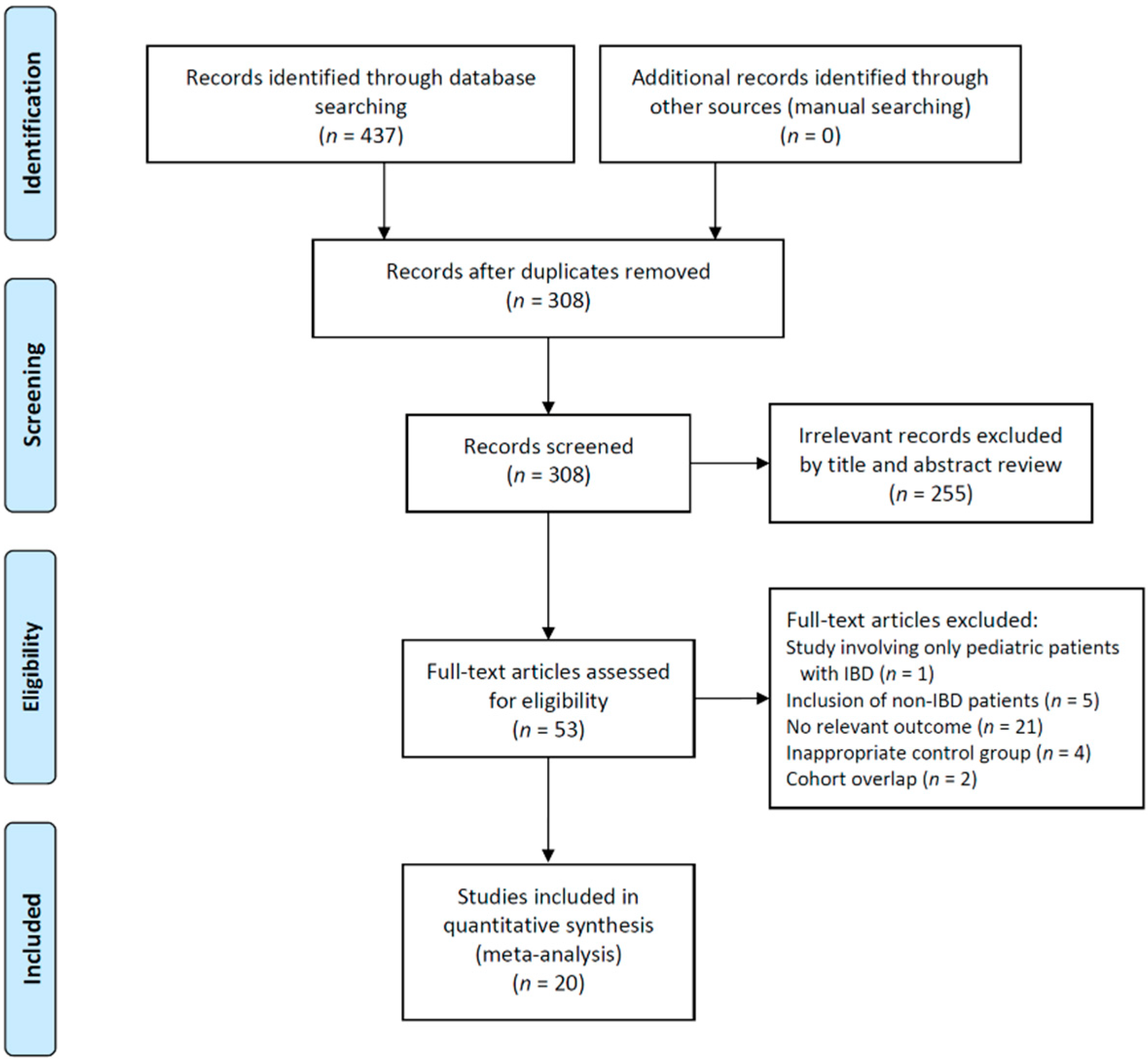
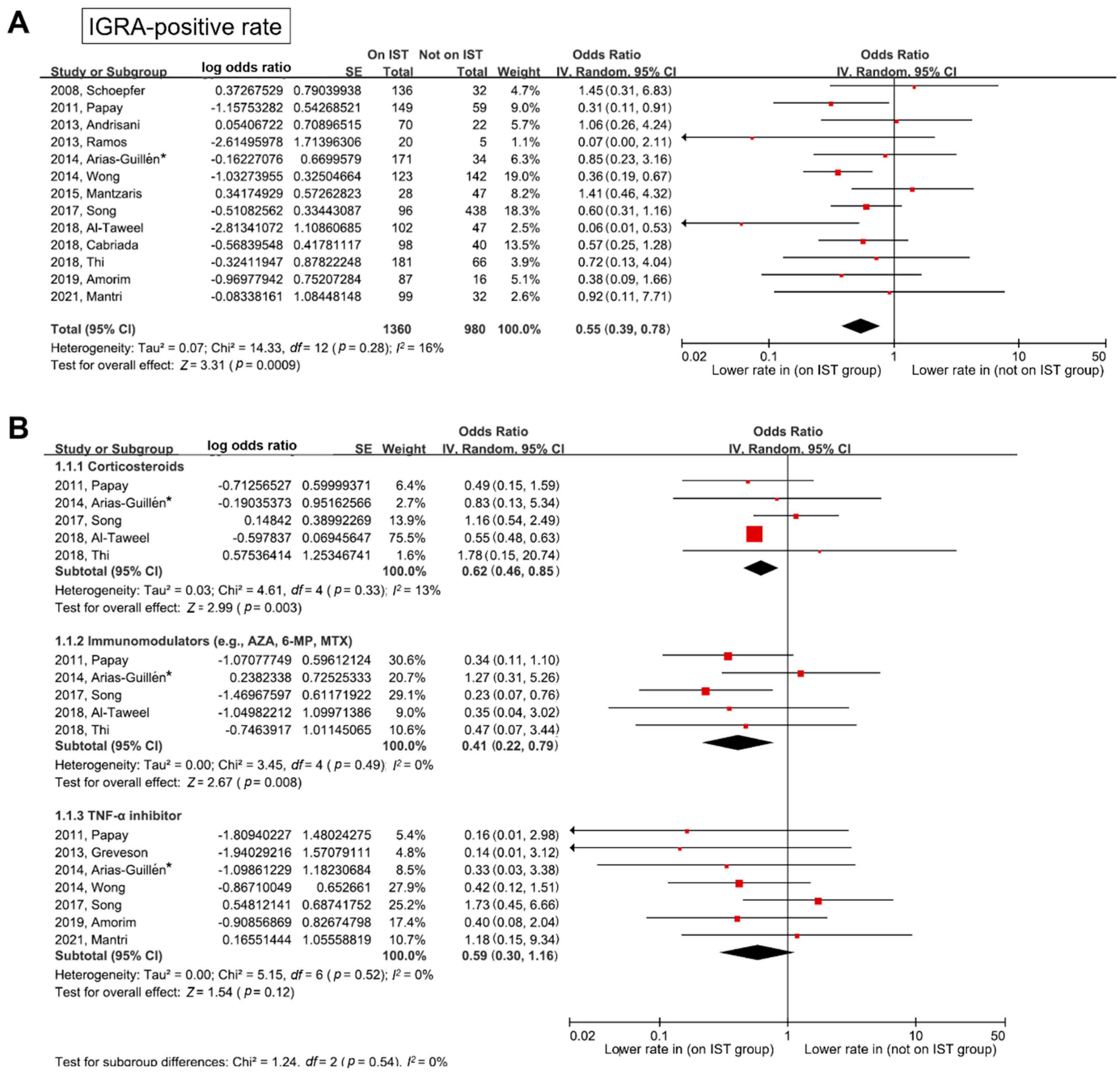
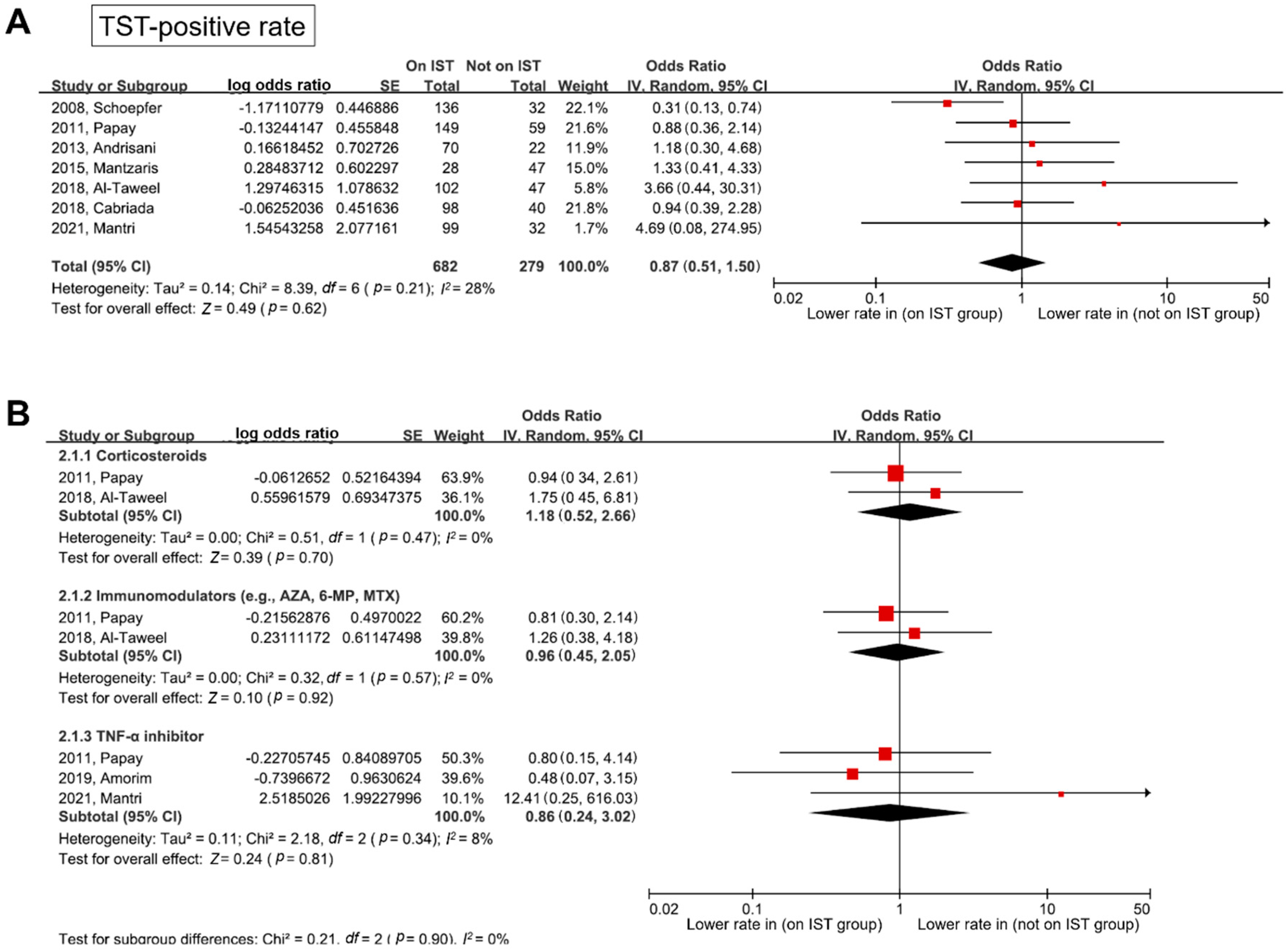
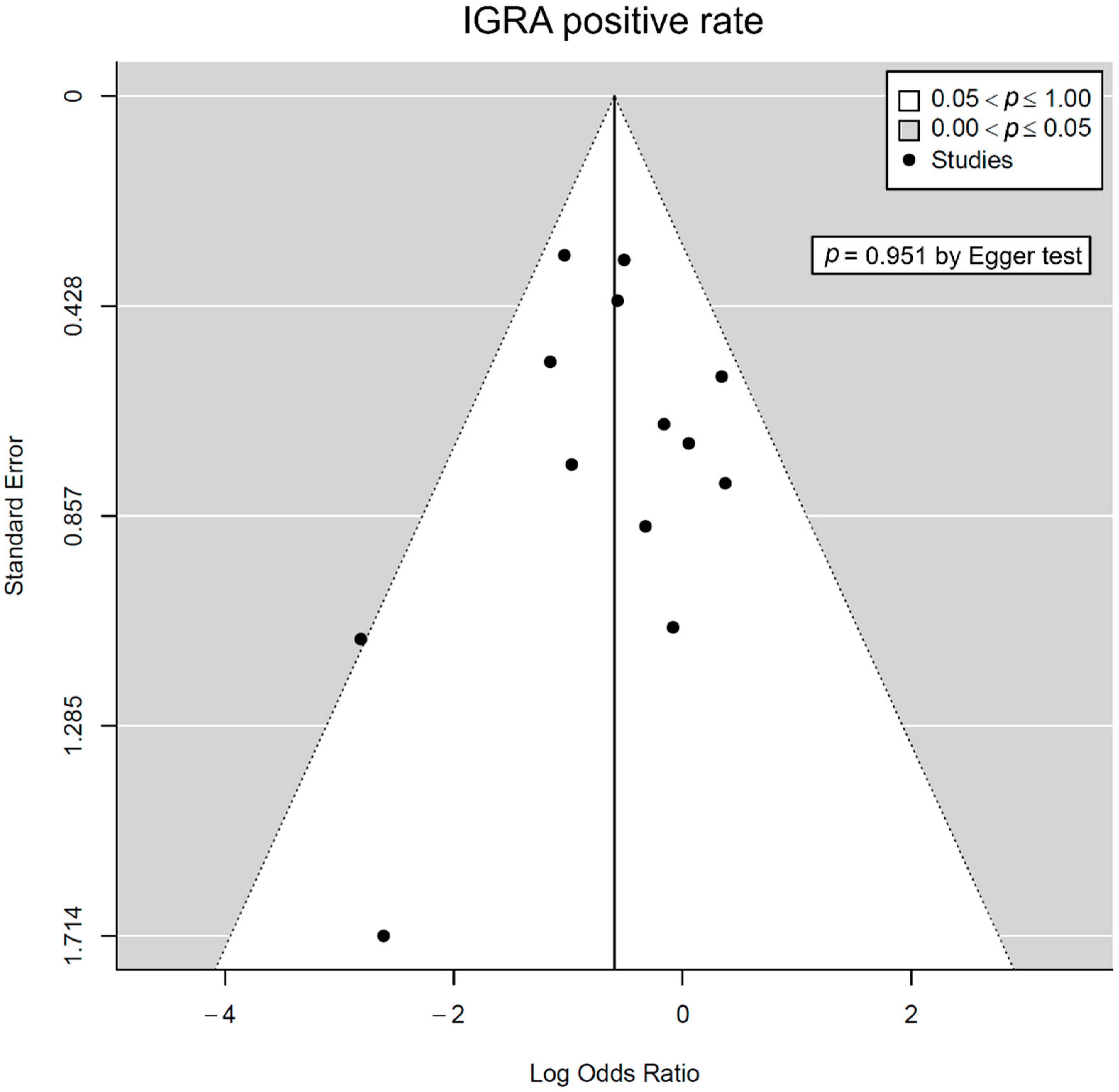
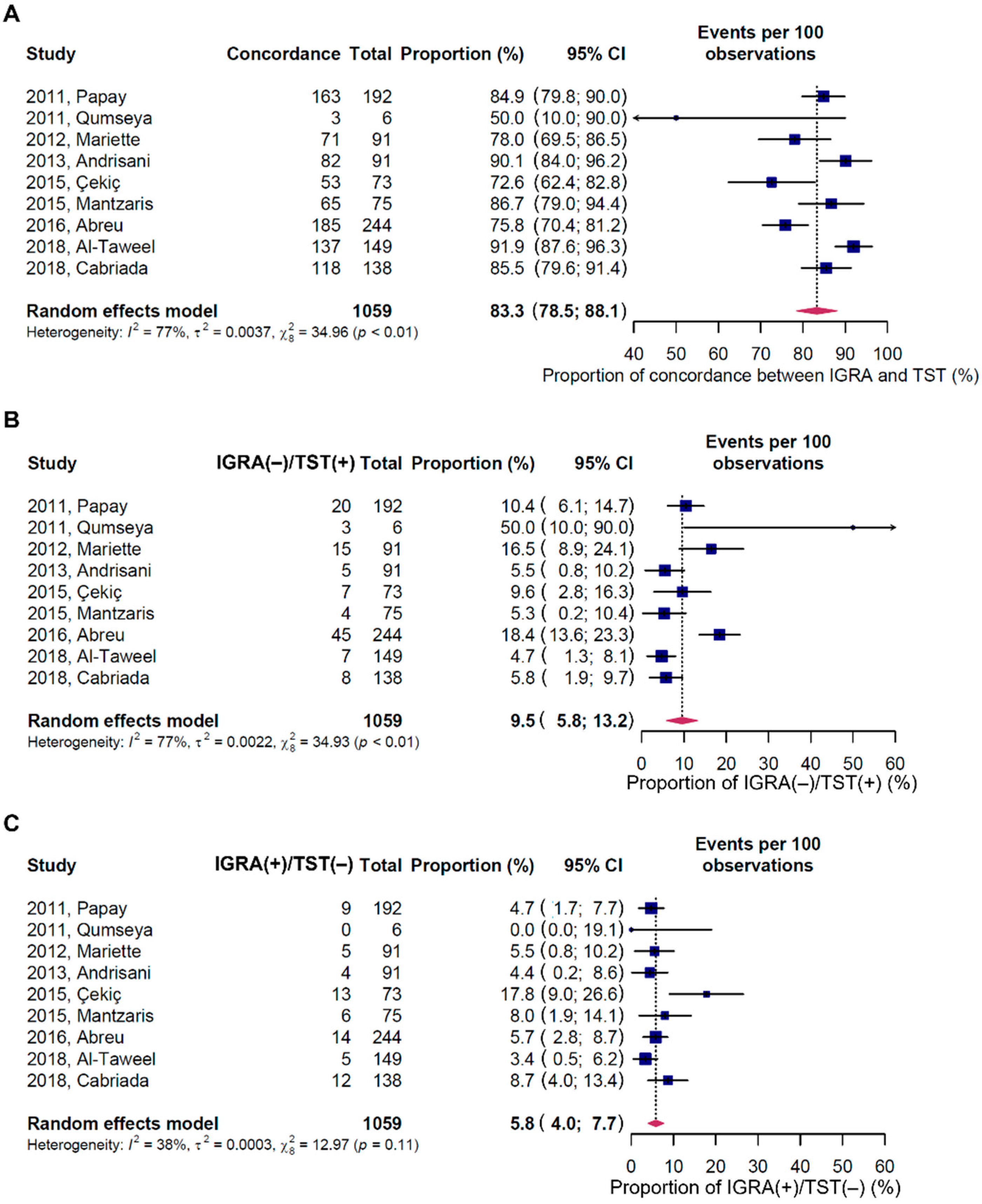
| Publication Year, First Author [Reference Number] | Study Design | Study Period | Country | Study Population | Number of Participants | Age, Year | Male, % | BCG Rate, % | Definition of IST | Medication for IST (%) a | IGRA Method | TST Cutoff, mm | Newcastle–Ottawa Scale (Selection/Comparability/Outcome) |
|---|---|---|---|---|---|---|---|---|---|---|---|---|---|
| 2008, Schoepfer [22] | Prospective cohort | 2006–2007 | Switzerland | CD: 114 UC: 44 Indeterminate colitis:10 | 168 | Mean 41 | 49.4 | 70.2 | Prednisone ≥15 mg/day (or equivalent dose of corticosteroid) for ≥1 month, AZA ≥ 2 mg/kg, 6-MP ≥ 1 mg/kg, MTX ≥ 15 mg/week, or TNF-α inhibitor | AZA (39.9) 6-MP (11.9) MTX (16.7) Steroids (25.0) IFX (14.9) | QFT | 5 (contact with TB, changes on chest X-ray, organ transplant, immunosuppressed state), 10 (high risk for TB), 15 (low risk for TB) | 4/1/3 |
| 2011, Papay [23] | Prospective cohort | 2006–2009 | Austria | CD: 152 UC: 56 | 208 | Mean 36.6 | 48.6 | 100.0 | Steroids at any dose ≥2 weeks, thiopurines or MTX ≥ 3 months, or TNF-α inhibitor within the last 12 weeks | Thiopurines or MTX (47.1) Steroids (33.7) TNF-α inhibitor (8.7) Combination of different ISTs (16.8) | QFT | 5 (on IST), 10 (not on IST) | 4/1/3 |
| 2011, Qumseya [24] | Retrospective cohort | N/A | USA | CD: 296 UC: 44 | 340 | Mean 41 | 45.6 | N/A | Steroids, AZA, 6-MP, thioguanine, MTX, or TNF-α inhibitor | MTX (12.1) AZA (17.6) 6-MP (8.5) Thioguanine (0.3) Mycophenolate mofetil (1.2) Lenalidomid (0.3) TNF-α inhibitor (58.2) | QFT | 5 (on IST), 10 (not on IST) | 4/1/3 |
| 2012, Mariette [25] | Prospective cohort | N/A | France | CD: 91 | 91 | Median 36 | 47.2 | 65.9 | Corticosteroids or immunosuppressants | Corticosteroids (33.0) Other immuno-suppressants (44.0) Combination (61.5) | QFT or T-SPOT | 5 | 4/1/3 |
| 2013, Andrisani [26] | Prospective cohort | 2008–2010 | Italy | CD: 60 UC: 32 | 92 | Mean 39.6 | 50.0 | 1.1 | Prednisone ≥ 20 mg/day (or equivalent dose of corticosteroid) for ≥2 weeks, thiopurines (2–2.5 mg/kg/day) or MTX (10–15 mg/week) ≥3 months, or TNF-α inhibitor within the last 12 weeks | AZA (41.3) MTX (2.2) Steroids (32.6) | QFT | 5 (on IST), 10 (not on IST) | 4/1/3 |
| 2013, Greveson [27] | Retrospective cohort | 2008–2010 | United Kingdom | CD: 102 UC: 16 Indeterminate colitis: 7 | 125 | Range 27–45 | 51.2 | 87.2 | Steroids > 20 mg/day, AZA, 6-MP, MTX, or TNF-α inhibitor | Corticosteroid (17.6) Thiopurines (52.8) TNF-α inhibitor (28.0) | T-SPOT | Not applicable | 4/1/3 |
| 2013, Ramos [28] | Prospective cohort | 2009–2011 | Spain | IBD: 25 | 25 | Median 30 | 60.0 | 8.0 | Corticosteroids ≥ 5 mg/day for >4 weeks), cyclosporine ≥ 2.5 mg/kg/day, AZA ≥ 1 mg/kg/day, leflunomide 20 mg/day, or MTX ≥ 7.5 mg/week | Corticosteroid (20.0) AZA (76.0) | QFT | 5 | 4/1/3 |
| 2014, Arias-Guillén [29] | Prospective cohort | 2009–2011 | Spain | CD: 157 UC: 42 Indeterminate colitis: 6 | 205 | Mean 44 | 50.2 | 89.8 | Corticosteroids within the last 2 weeks, immunomodulators (AZA, 6-MP, or MTX) within the last 3 months, or TNF-α inhibitor within the last 12 weeks | Corticosteroids (13.2) Immunomodulators (31.2) TNF-α inhibitor (15.6) Combination of different ISTs (23.4) | QFT and T-SPOT | 5 | 4/1/3 |
| 2014, Wong [30] | Prospective cohort | N/A | China | CD: 128 UC: 136 Indeterminate colitis: 4 | 268 | Mean 43 | 59.7 | 73.1 | Prednisone 15 mg/day (or equivalent dose of corticosteroid) for ≥1 month, AZA, 6-MP, MTX, or TNF-α inhibitor | Corticosteroid, AZA, 6-MP, or MTX (46.4) TNF-α inhibitor (7.5) | QFT | 5 | 4/1/3 |
| 2015, Çekiç [31] | Retrospective cohort | 2007–2014 | Turkey | CD: 51 UC: 25 | 76 | Mean 42 | 69.7 | N/A | Prednisolone 20 mg/day (or equivalent dose of corticosteroid) for ≥2 weeks, AZA for ≥3 months, or TNF-α inhibitor | Corticosteroid (18.4) AZA (53.9) TNF-α inhibitor (100.0) | QFT | 5 | 4/1/3 |
| 2015, Mantzaris [32] | Prospective cohort | 2008–2010 | Greece | CD: 53 UC: 22 | 75 | Median 37 | 56.0 | 63.4 | Thiopurines | Thiopurines 37.3 | QFT | 5 (on IST), 10 (not on IST) | 4/1/3 |
| 2016, Abreu [33] | Prospective cohort | 2012–2015 | Portugal | CD: 203 UC: 47 | 250 | Median 36 | 43.6 | 100.0 | Steroids ≥ 2 weeks, thiopurines ≥ 2 months, MTX ≥ 2 months, cyclosporine ≥ 2 months, or TNF-α inhibitor | Steroids (10.0) AZA (30.0) Steroids + AZA (18.0) MTX (0.4) Steroids + AZA + MTX or cyclosporine (0.8) TNF-α inhibitor (8.0) TNF-α inhibitor + other ISTs (17.6) | QFT | 5 | 4/1/3 |
| 2017, Song [34] | Retrospective cohort | 2011–2016 | China | CD: 187 UC: 300 Indeterminate colitis: 47 | 534 | Mean 39.6 | 63.3 | N/A | Prednisone ≥ 20 mg/day (or equivalent dose of corticosteroid) for ≥2 weeks within the last 3 months, any dose of AZA, MTX, thalidomide, or cyclosporine within the last 3 months, or TNF-α inhibitor within the last 12 weeks | N/A | T-SPOT | Not applicable | 4/2/3 |
| 2017, Taxonera | Prospective cohort | N/A | Spain | CD: 349 UC: 223 | 580 | Mean 42.6 | 55.3 | 22.4 | Steroid at any dose for ≥2 weeks, AZA for ≥2 months, 6-MP for ≥2 months, MTX for ≥2 months, or TNF-α inhibitor | Steroids (6.5) AZA, 6-MP, MTX (15.4) TNF-α inhibitor (10.1) Combination of different ISTs (37.5) | Not applicable | 5 | 4/1/3 |
| 2017, Vajravelu | Retrospective case–control | 2009–2014 | USA | CD: 163 UC: 68 Indeterminate colitis: 9 | 240 | <45 years, 59.2% 45–65 years, 31.3% >65 years, 9.6% | 46.3 | N/A | Corticosteroids, immunomodulators (AZA, 6-MP, or MTX), or TNF-α inhibitor | Corticosteroids (46.3) Immunomodulators (21.3) TNF-α inhibitor (17.5) | QFT | Not applicable | 3/2/3 |
| 2018, Al-Taweel | Prospective cohort | 2010–2014 | Canada | CD: 127 UC: 21 Indeterminate colitis: 1 | 149 | Mean 38.1 | 51.7 | 17.5 | Corticosteroids ≥ 15 mg for >4 weeks, thiopurines, or MTX | Corticosteroids (43.6) Thiopurines (30.9) Methotrexate (6.7) | QFT | 5 (low risk for TB), 10 (high risk for TB) | 4/2/3 |
| 2018, Cabriada | Prospective cohort | N/A | Spain | CD: 112 UC: 26 | 138 | Median 39.5 | 55.8 | N/A | Prednisone ≥ 15 mg/day (or equivalent dose of corticosteroids) for ≥1 month, immunomodulators, including AZA, 6-MP, and MTX, for ≥3 months, or TNF-α inhibitor ≥ 3 months | Corticosteroids (23.2) Immunomodulators (29.7) TNF-α inhibitor (0.7) Combination of different ISTs (17.4) | QFT | 5 (on IST), 10 (not on IST) | 4/2/3 |
| 2018, Thi | Retrospective cohort | 2007–2015 | United Kingdom | CD: 173 UC: 74 | 247 | Median 34 | 53.8 | N/A | Corticosteroids, thiopurines, MTX, tacrolimus, or mycophenolate | Corticosteroids (7.7) Thiopurines (49.0) MTX (3.6) Tacrolimus or mycophenolate (2.8) Combination of different ISTs (10.1) | N/A | Not applicable | 4/1/3 |
| 2019, Amorim | Prospective cohort | 2015–2017 | Brazil | CD: 83 UC: 20 | 103 | Mean 37.6 | 43.7 | 98.1 | Prednisone ≥ 20 mg/day for ≥2 weeks, immunomodulators (AZA, 6-MP, or MTX) within the last 3 months, or TNF-α inhibitor within the last 3 months | Corticosteroids (4.9) Immunomodulators (16.5) TNF-α inhibitor (10.7) Combination of different ISTs (52.4) | QFT | 5 | 4/1/3 |
| 2021, Mantri | Prospective cohort | N/A | India | CD: 121 UC: 10 | 131 | Mean 36.0 | 55.0 | 22.9 | Steroids for ≥2 weeks, thiopurines for ≥2 months, MTX for ≥2 months, cyclosporine for ≥2 months, or TNF-α inhibitor | Steroids (69.5) AZA (50.4) TNF-α inhibitor (34.4) | QFT | 5 (on IST), 10 (not on IST) | 4/2/3 |
Publisher’s Note: MDPI stays neutral with regard to jurisdictional claims in published maps and institutional affiliations. |
© 2022 by the authors. Licensee MDPI, Basel, Switzerland. This article is an open access article distributed under the terms and conditions of the Creative Commons Attribution (CC BY) license (https://creativecommons.org/licenses/by/4.0/).
Share and Cite
Park, C.H.; Park, J.H.; Jung, Y.S. Impact of Immunosuppressive Therapy on the Performance of Latent Tuberculosis Screening Tests in Patients with Inflammatory Bowel Disease: A Systematic Review and Meta-Analysis. J. Pers. Med. 2022, 12, 507. https://doi.org/10.3390/jpm12030507
Park CH, Park JH, Jung YS. Impact of Immunosuppressive Therapy on the Performance of Latent Tuberculosis Screening Tests in Patients with Inflammatory Bowel Disease: A Systematic Review and Meta-Analysis. Journal of Personalized Medicine. 2022; 12(3):507. https://doi.org/10.3390/jpm12030507
Chicago/Turabian StylePark, Chan Hyuk, Jung Ho Park, and Yoon Suk Jung. 2022. "Impact of Immunosuppressive Therapy on the Performance of Latent Tuberculosis Screening Tests in Patients with Inflammatory Bowel Disease: A Systematic Review and Meta-Analysis" Journal of Personalized Medicine 12, no. 3: 507. https://doi.org/10.3390/jpm12030507
APA StylePark, C. H., Park, J. H., & Jung, Y. S. (2022). Impact of Immunosuppressive Therapy on the Performance of Latent Tuberculosis Screening Tests in Patients with Inflammatory Bowel Disease: A Systematic Review and Meta-Analysis. Journal of Personalized Medicine, 12(3), 507. https://doi.org/10.3390/jpm12030507






